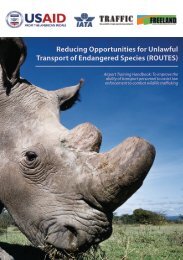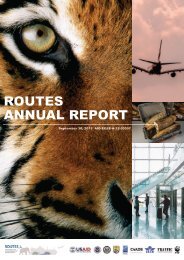ROUTES Annual Report 2018
Create successful ePaper yourself
Turn your PDF publications into a flip-book with our unique Google optimized e-Paper software.
ROUTES Crosscutting: Monitoring, Evaluation & Learning
14
Monitoring, Evaluation & Learning
ROUTES’ engagement and impact with priority companies,
governing bodies and airports
In accordance with its
identification of wildlife
trafficking hotspots, ROUTES
has prioritized engagement with
airports and airlines in Eastern
and Southern Africa, South-East
Asia and Pacific, and, to a lesser
extent, Europe and the Middle
East. Efforts are concentrated
where priority company and
airports are linked (shown by
the line between airline and
port). ROUTES also engages
US airlines and other global
carriers, and has worked with
several airline governing bodies,
for global impact.
Objective 1
Achievement
Wildlife seizure data analysis and production of
ROUTES’ second public report, In Plane Sight, with
two accompanying webinars;
Completion of five wildlife trafficking gap assessments
at priority airports.
Objective 2
Continued engagement with aviation companies, with
new relationships built and commitments made to
take action.
Objective 3
Wildlife trafficking awareness workshops conducted
at eight locations;
Development of six role-specific e-learning modules.
Objective 4
Support provided to industry governing bodies to
revise guidance documents;
Submission of working paper on wildlife trafficking
as a potential secondary security threat at the ICAO
AVSEC Panel
Objective 5
Installation of three interactive learning displays at
priority airports;
Production of business-to-business (B2B)
communications toolkit
Impact
• 59 air transport industry members reached by webinar
• 230 downloads of the report
• Commonalities revealed in capacity needs of airports
• 18 priority companies engaged and 10 have taken action
• 57 airlines have signed the UfW Transport Taskforce Buckingham
Palace Declaration
• 700+ personnel trained, 87-100% know how to identify wildlife
trafficking after the training
• Learning modules hosted on the IATA website will have the
potential to reach over 270 airlines
• Three industry guidance documents adopted, with a fourth document
endorsed;
• Socialization of wildlife trafficking to be recognized as a secondary
security threat
• Potentially thousands of priority transport personnel reached by
installations;
• B2B toolkit will enable company awareness raising across the
industry





